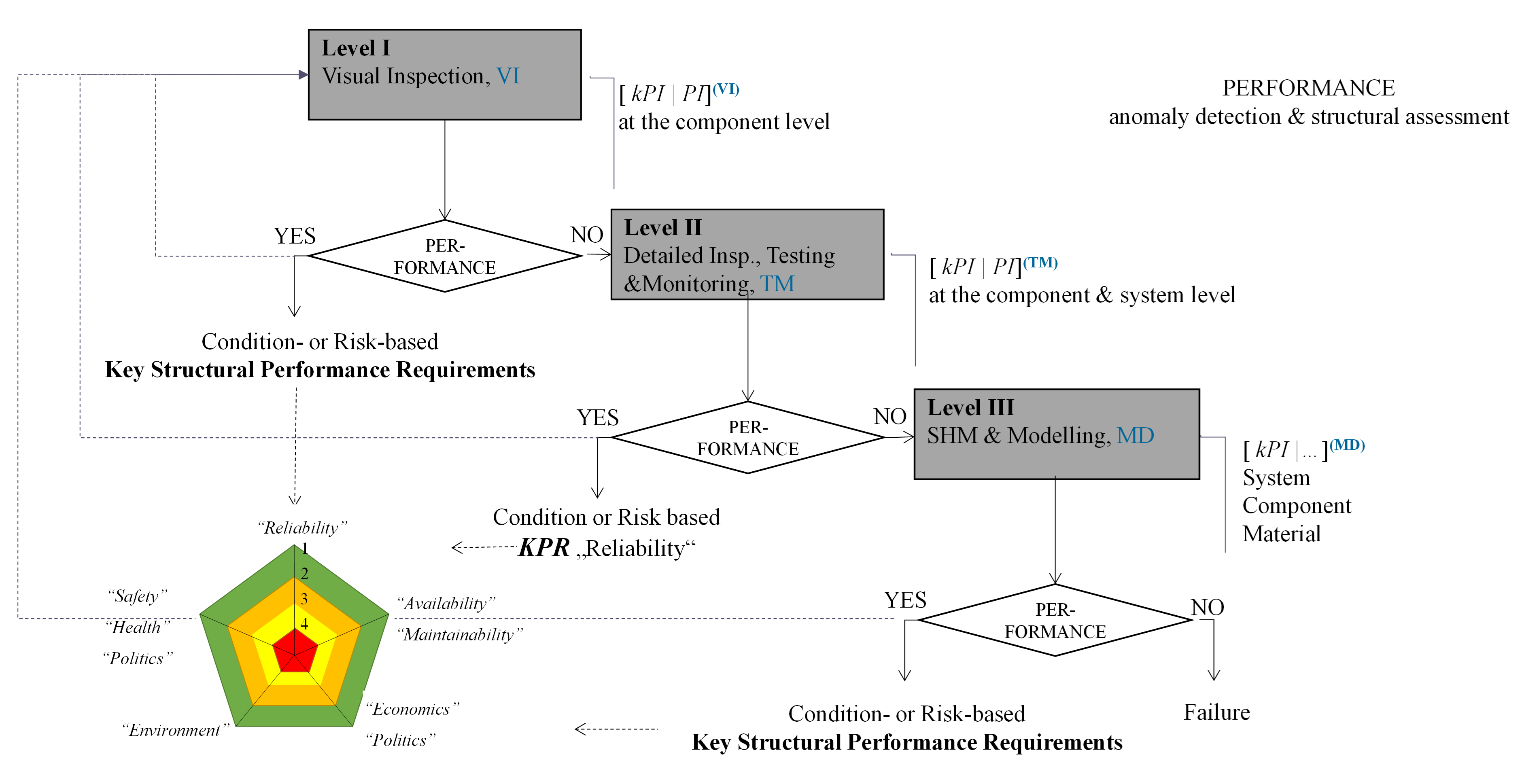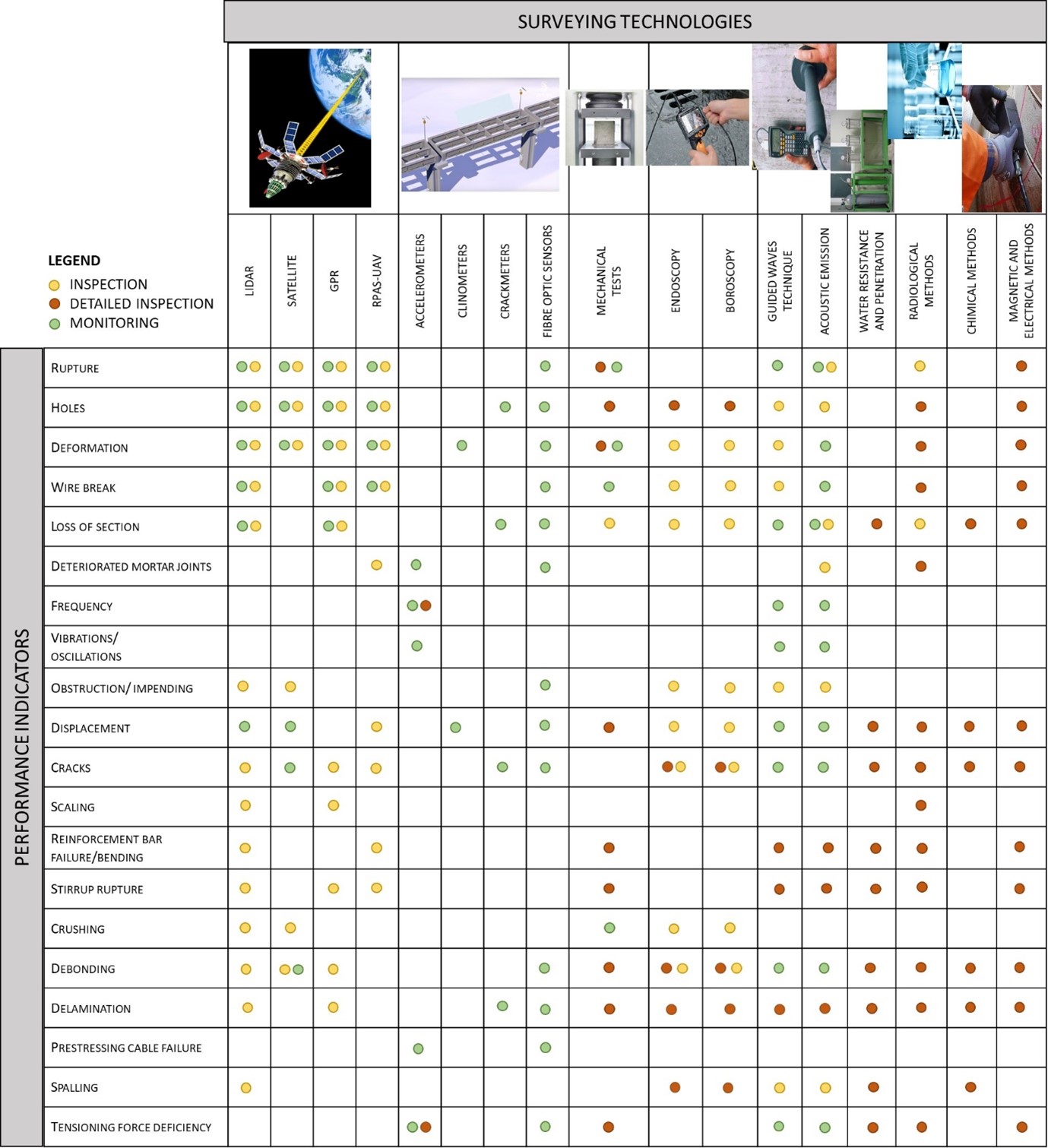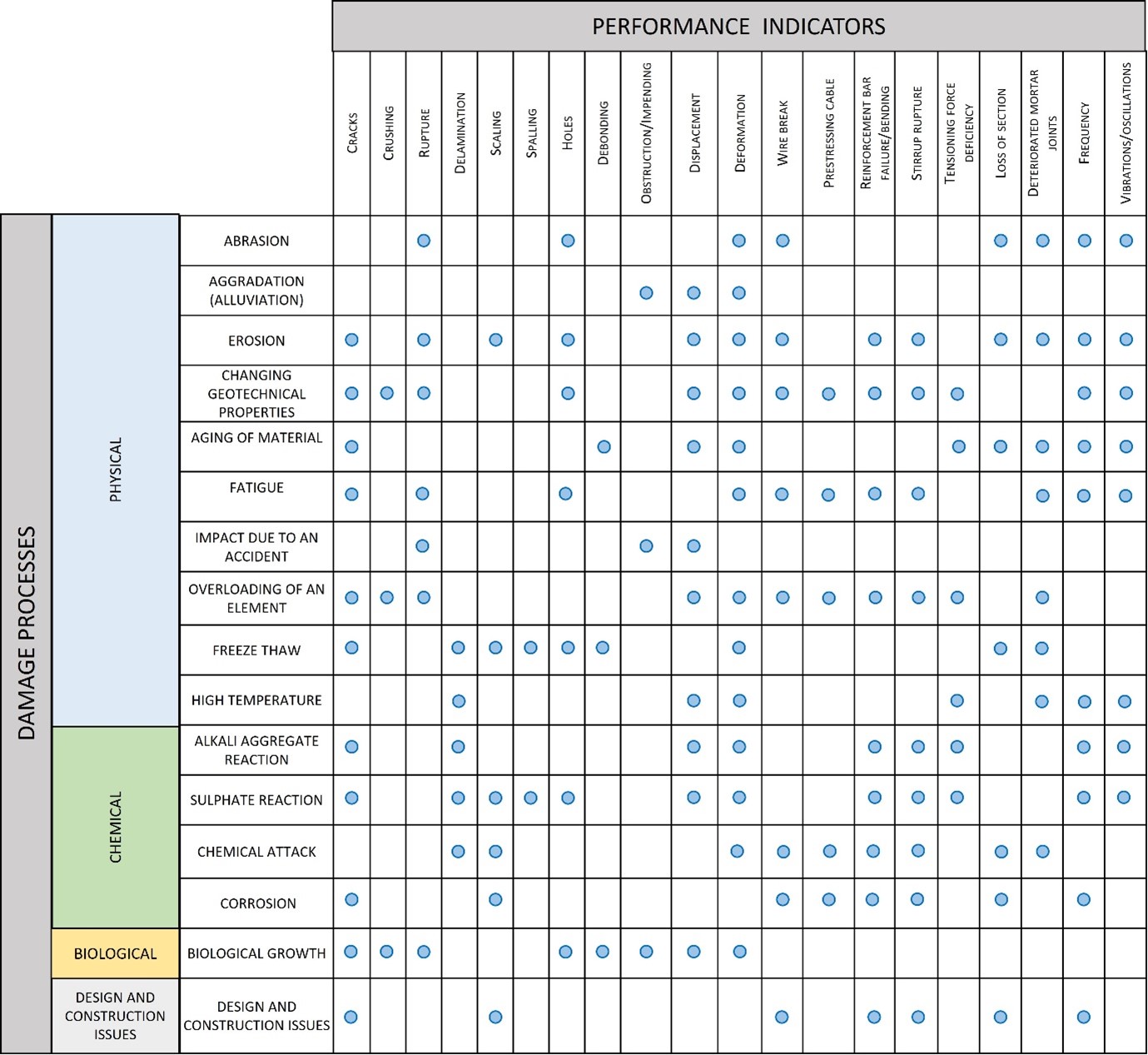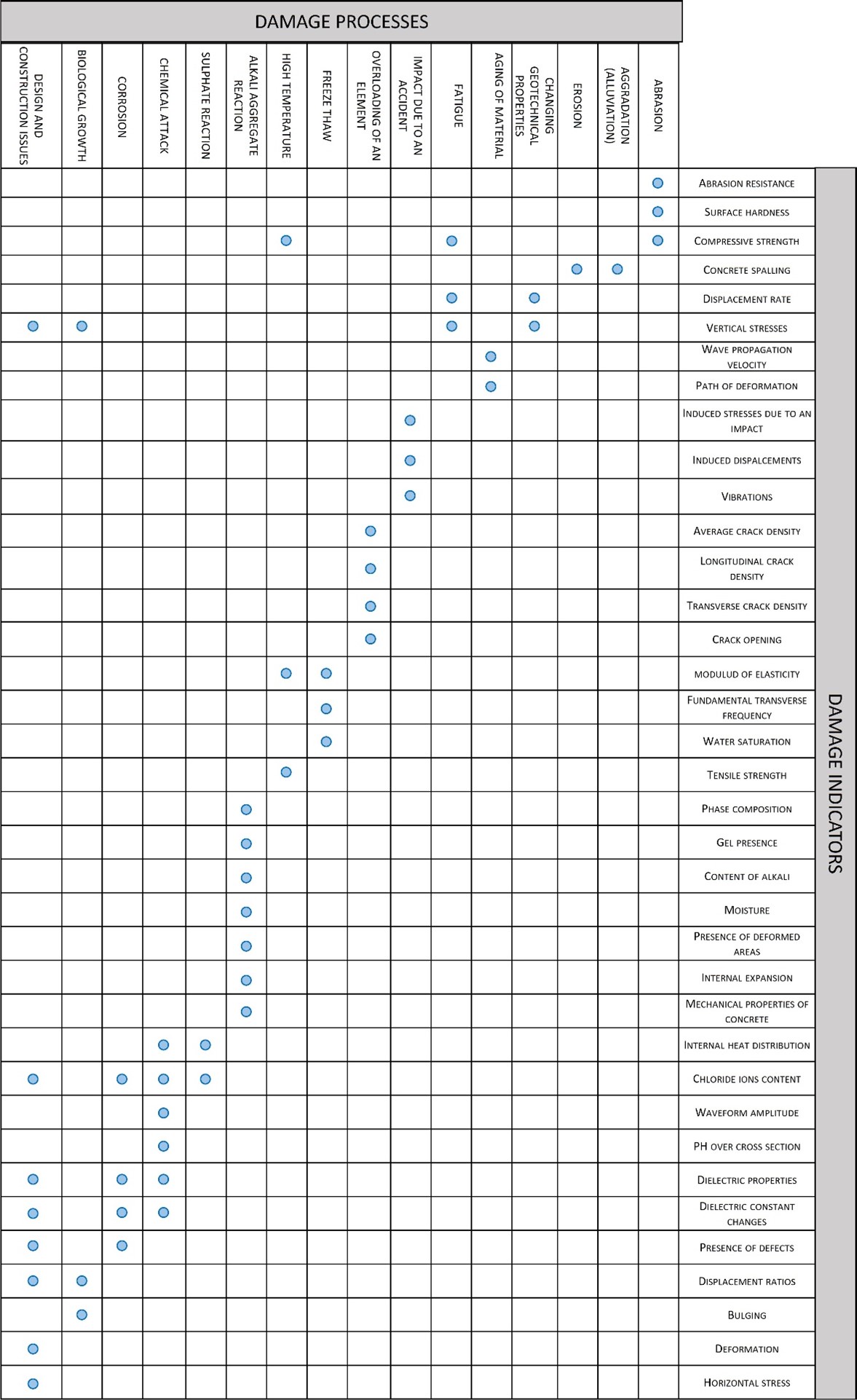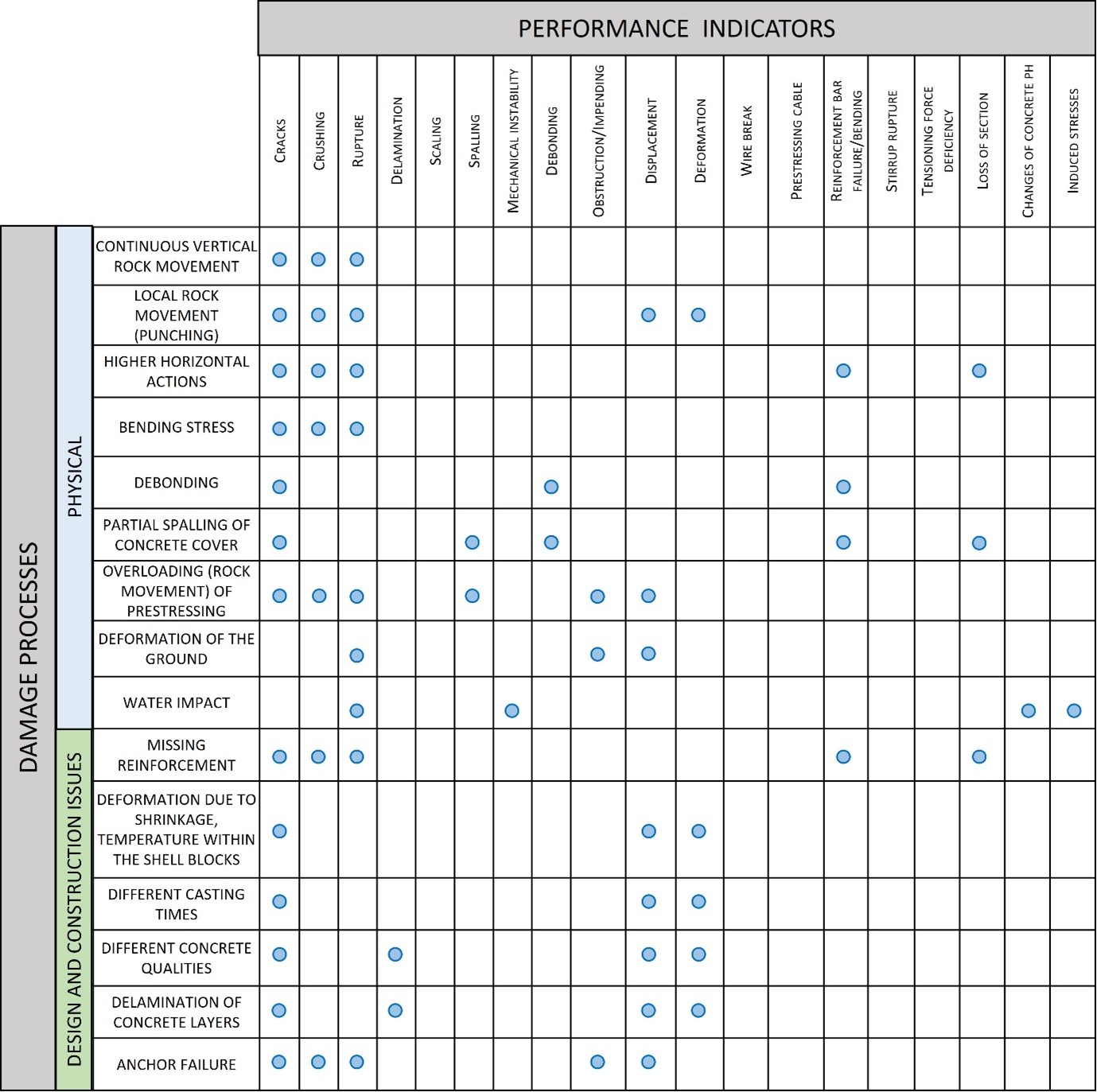Key performance indicators
In general, performance can be defined as the efficiency of a system under consideration (the efficiency with regard to structural behaviour is referred to as structural performance). In the Civil Engineering field, the concept of efficiency can be applied to structures at various schema levels, according to the assessment type and the scope of the analysis. For the infrastructure framework, the relevant levels can be described as:
- Network: an aggregate of interconnected objects that collectively fulfil a function;
- System: a delimited group of interrelated, interdependent or interacting objects that is assessed for a potential risk. A structural system is specifically an arrangement of interacting structural members offering a potential solution to provide bearing resistance to a specified combination of actions;
- Component: individually identifiable part of an object consisting of one or more elements, designed to provide a specific function for the object; specifically, a structural component is a portion of the structural system to be used as load-bearing part of works designed to provide mechanical resistance and stability to the works and/or fire resistance, including aspects of durability and serviceability.
For all levels under consideration, the goals set for the asset management must be attained. When setting these goals, the multiple levels of objectives and multiple layers in posing requirements and creating constrains must be distinguished and adequately considered. As schematically shown in Figure 1, the primary objectives of asset management are set at the highest strategic level by the Policy objectives, prevailing legislation, and administrative agreements. Examples of objectives considered for infrastructure at this level include e.g. mobility, climate adaptability, energy neutrality. These strategic objectives are governing when the primary requirements are set for the function of the infrastructure during its life cycle and when the primary requirements are set for the properties that do not affect the basic functionality of the infrastructure but have impact on user expectations. These requirements are referred to as the functional requirements and the non-functional requirements. Both categories of targets should be clearly specified in terms of aspect requirements.
Figure 1: Multiple levels of objectives and multiple layers considered in identifying requirements for the infrastructure assets IMSAFE D3.1
Aspect requirements considered for infrastructure usually include: reliability, availability, maintainability and safety (RAMS), sometimes extended by including security, health, environment, economics and politics (RAMSSHE€P). The aspect requirements are established by means of the (Key) Performance Requirements, whereas the Key Performance Requirements (KPR) are the (main) requirements set for the primary functions or properties for all aspects considered, specified in terms of performance. Examples of KPRs considered for infrastructure include requirements with regard to structural performance, which comprise, for instance, the requirements associated to structural safety, serviceability, durability, robustness or redundancy. Table 1 defines KPRs of RAMSSHE€P for both tunnels and bridges.
| KPR | Definition |
|---|---|
| Safety | The probability of causing damage to the health and safety of the public. Safety is related to minimizing or eliminating the harm to people during the service life of a structure (the loss of life and limb due to structural failure is not included). |
| Reliability | The probability that a structure will be fit for purpose (i.e. able to carry out the work that is designed to perform, within specified limits of performance for a specified interval of time under stated conditions during its service life. The reliability with regard to structural safety is included. |
| Security | The aspect of security stands for the safety of a system with regard to
conscious unsafe human action, such as vandalism, terrorism and cybercrime. |
| Availability | Time proportion in which a system is in a functioning condition incl. disruption originates from planned maintenance interventions. |
| Maintainability | The probability that a given active maintenance action for an item, under given conditions of use, can be carried out within a stated interval when the maintenance is performed under stated conditions and using stated procedures and resources. Maintainability refers to features with which a structure can be maintained to repair the damage or its cause, repair or replace defective components without having to replace still-working parts, and avoid unforeseen maintenance measures. |
| Owner’s costs | Adequate life cycle costs for the owner incl., construction maintenance and operation costs, costs of claims and fines, etc. |
| Social costs | Acceptable and rare detours/accidents related to minimizing long-term costs and maintenance activities over the service life of a structure. Herein the user costs incurred due to detours and delays are not included. |
| Greenhouse gas emissions Resource consumption Waste generation |
Associated with minimizing negative impact on the environment during the life cycle of a structure and balancing impact with the utility of the structure. |
| Health | The physical, mental and/or social well-being, without failure or acute illness incl. absence of causes of diseases other than failure (for example, the use of asbestos), which in most cases is regulated. It relates to users of the infrastructure, persons working on or near the infrastructure and - where applicable - the infrastructure itself. |
| Politics | Reflects political-administrative and social consequences, e.g. the elimination of the causes of public protest, effects on the image protection of the management organisation or consequences for the reputation of the politically/administratively responsible parties responsible persons Includes etc. |
The KPR’s shall be established by means of the performance criteria, which are the quantitative limits, associated to a performance requirement, defining the border between desired and adverse behaviour. With regard to structural performances, in context of limit state design, performance criteria are the threshold values that describe for each limit state the conditions to be fulfilled (in the reliability-based approach the performance criteria are established by limit state functions with associated reliability targets for a defined reference period).
Assessment levels
In the IM-SAFE project the performance assessment of a structure, or any other asset, has been divided into a minimum of three levels, reflected in the decision-making flow. Figure 2 introduces these levels in a flow chart:
- Level I- Visual Inspections
- Level II- Detailed Inspections, Testing and Monitoring
- Level III- SHM & Modelling
Figure 2: Performance assessment according to the different inspection levels (Level I Visual Inspections; Level II Detailed Inspections, Testing and Monitoring; Level III SHM and Modelling) for the comparison with the Key Performance Requirements
Level I: Preliminary assessment (Visual Inspections)
The purpose of Level I is to remove existing doubts about the performance using fairly simple methods, which must, however, be adequate. The preliminary evaluation consists of a rough assessment based on inspection, an accompanying study of the available documents, and a rough check on the structural safety. In this first level, it makes sense to distinguish between key performance indicators, which allow a rough assessment, and performance indicators for detailed inspection and to define performance targets and performance thresholds.
The information gained in Level I must be summarised in a report for the owner and must result in Key Performance Requirement Indexes (KPRs) for the strategic asset management and budget allocation. The performance evaluation shown in Figure 2 is based on anomaly detection and leads to the KPR level or, in case of an insufficient condition, to level II.
Level II: Detailed investigations (Detailed Inspections, Testing and Monitoring)
Structural investigations and updating of information are typical of Level II – it comprises detailed inspection, testing and monitoring among others. The additional information gained e.g. from the performance indicators of these investigations can be introduced into confirmatory calculations with the aim of finally dispelling or confirming any doubts as to whether the structure is safe.
A detailed inspection of the structure or structural part in question is extremely important, especially the recognition of typical hazard scenarios that could endanger the structure’s residual service life. Further any defects and damage process due to excessive loading must be detected e.g. by using the visual inspection associated observations or performance indicators.
Performance indicators or observations in these levels are mainly received from detailed inspection, testing and monitoring. As in the first level, it is recommended to distinguish between key performance indicators, which allow an assessment based on a minimum of detailed inspection, testing or monitoring related observations, and performance indicators associated with detailed testing and monitoring.
The results of Level II must be summarised in a report. In particular, the report must give information on the structural safety based on the performance indicator findings of levels I and II, and must contain the information about the Performance Requirement Indexes (RPIs) for e.g. network assessment purposes.
Level III: Assessment and prediction by advanced analysis (SHM & Modelling)
For problems with substantial consequences, an advanced analysis for performance assessment and performance prediction should be planned to check carefully the proposal for the pending decision that results from level I and II. In assessing an existing structure, such an analysis (see Figure 2) acts to a certain extent as a substitute for the codes of practice, which for new structures constitute the rules to follow in a well-balanced and safe design. In particular, the acceptance of increased risks should be left to the assessment team of experts.
In this level, extended surveys such as continuous monitoring or SHM are usually necessary for the in-depth analyses with regard to levels I and II for the determination of the analysis input variables. Some of the observations in these surveys of the input variables as well as some of the analysis responses are suitable for the performance assessment and can therefore be assigned to the class of performance indicators. In this level III, the distinction between key performance and performance indicators can be applied analogously to levels I and II.
These principles have been implemented in the assessment and decision making flow, as input at various level of the analysis process.
Performance indicators at the network level
At the network level, based on bridge condition assessment gained through standard inspection and evaluation procedures with additional evaluation of bridge importance in the network, the primary goal to be reached is supporting the maintenance management and asset management decision process. Priority repair ranking, is an example of the essential indicator for the final goal: optimal management plan of road-/railway bridges, which is to be evaluated through decision ranking by power and weakness of decisions. While the bridge or tunnel structural performance assessment is based on four criteria: structural safety, serviceability, durability, and robustness related to the (general) condition of the structure, the bridge importance in the network is based on five criteria: road category, annual average daily traffic, detour distance, largest span, total length. Such criteria are usually reduced to comparable values with the help of preference functions and with the help of an adequate thresholds of indifference and preference for each criterion. Indicators for the key performance requirements are determined at this level.
Performance indicators at the system level
A qualitative assessment can show how the collapse of a particular element would affect the individual Structural Performance Requirements. Structural performance assessment at the system level will require an adequate knowledge level on particular PIs and DI with related properties, such as e.g. stiffness changes traffic load characteristics, which may require investment in additional inspection, testing or monitoring method, advanced modelling techniques and updating data on resistance and loads. Besides technical indicators, at this level sustainability and socio-economic indicators will have an essential position within the set of the performance requirements. Additionally, indicators related to scientific achievements in, for example, testing and monitoring, dynamic behaviour and reliability of structures, should be elaborated at this level, as well.
Performance indicators at the component level
Inspections of structures are generally carried out at the level of components. For bridges, three main subsystems can de distinguished: substructure, superstructure and road-/railway, with specific bridge components associated with these systems, including constitutive materials. For tunnel systems, a similar decomposition is possible, distinguishing e.g. ridge, callous, abutment and base area, or inner shell, outer shell and sealing level. At the component level, one of the important goals to be reached (or task to be performed) is the damage assessment. This implies the detection of damages but also the identification and evaluation of damage within the set thresholds. The categorisation of damage as a primary performance indicator at the component level, requires considering related detection methods, performance thresholds and evaluation methods.
Performance Indicators (PIs), Damage Indicators (DIs), damage processes, surveying technologies and performance assessment levels can be correlated.
For this purpose, the following tables have been built, summarizing information included in D2.2:
- PIs vs surveying technologies, which also includes a colour scale regarding the analysis phase in which the specific technology is being used.
- Damage process vs DIs
- Damage process vs PIs
The combined use of the tables above allows to define which are the best surveying techniques to be used in order to identify each damage process and which are the related Damage and Performance Indicators.
Figure 3: PIs vs Surveying technologies (for both bridges and tunnels) (Extract from (IM-SAFE WP2, 2022 (under review)))
Figure 4: Damage process vs PIs (bridges) (Extract from (IM-SAFE WP2, 2022 (under review)))
Figure 5: Damage process vs DIs (bridges) (Extract from (IM-SAFE WP2, 2022 (under review)))
Figure 6: Damage process vs PIs (bridges) (Extract from (IM-SAFE WP2, 2022 (under review)))
Figure 7: Damage process vs DIs (tunnels) (Extract from (IM-SAFE WP2, 2022 (under review)))

